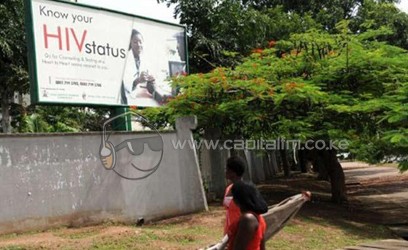
UNICEF estimates HIV/AIDS prevalence among those aged between 15 and 49 years is 6.3 percent/AFP-File
This follows the launch of a new nationwide survey by the government that will be more comprehensive compared to the previous Kenya Indicator Surveys (KAIS) that targeted persons between the ages of 15 and 49 years.
Public Health and Sanitation Permanent Secretary Mark Bor said the survey will help realign the country’s HIV/AIDS prevention and control strategies in addition to facilitating plans for combating the scourge.
According to the United Nations Children’s Fund (UNICEF) the estimated HIV/AIDS prevalence rate among those aged between 15 and 49 years is 6.3 percent.
The organisation further estimates that about 180,000 children between 0-14 years are HIV positive.
“This is an important exercise that will give planner information on what needs to be done in future to achieve the objectives of the Kenya National HIV/AIDS Strategic Plan and Millennium Development Goals,” said Bor.
He further revealed that this year’s survey would cover 10,000 households drawn from all the counties in the country and would be administered at a household level.
It will include individual questionnaires as well as home-based counselling and testing.
The questionnaire will gather basic information from the heads of the house in addition to determining who qualifies for the survey.
“It is however important to note that this will be done on a voluntary basis and those eligible for the survey will be asked for their verbal permission to participate. Parents will also be asked to provide their verbal permission for their children to participate,” he explained.
Participants will include children between 18 months and 14 years and men and women between the ages of 15 and 64 years.
Children aged between the ages of 10 and 14 years will have a special questionnaire.
“The individual questionnaire will cover basic demographic characteristics, reproductive history, fertility preferences, family planning, marriage and sexual activity,” explained the PS.
“The interviewers will also seek information on HIV and STI knowledge, testing, attitudes and behaviour as well as access to healthcare,” he added.
The first KAIS was conducted in 2007 and it showed that a vast majority of HIV infected persons did not know their HIV status and that most were willing to be tested in their homes. This enabled the establishment and scale up of home based counselling in Kenya.
The National AIDS and STI Control Programme (NASCOP) will have the overall responsibility for all the technical and administrative activities in the survey.
“It will also provide the laboratory technicians, nurses, Voluntary Counselling and Testing counsellor and other health personnel who will be involved in the survey,” explained NASCOP Strategic Information, Surveillance and Research Manager Davies Kimanga.
Other partners who will also be involved in the survey are the Kenya National Bureau of Statistics who will develop the sampling plan, the National Public Health Laboratory Services who will be involved in the collection of blood samples and the Kenya Medical Research Institute who will provide technical input.









































